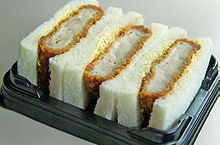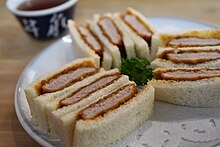Tonkatsu
You can helpexpand this article with text translated fromthe corresponding articlein Japanese.(January 2020)Click [show] for important translation instructions.
|
 | |
| Place of origin | Japan |
|---|---|
| Region or state | East Asia |
| Main ingredients | Cutlet(porkfillet or loin),panko,cooking oil |
Tonkatsu(Heo カツ,とんかつorトンカツ,pronounced[toŋkatsɯ];"porkcutlet")is a Japanese dish that consists of abreaded,deep-friedporkcutlet. It involves coating slices of pork withpanko(bread crumbs), and then frying them in oil. The two main types are fillet and loin. Tonkatsu is also the basis of other dishes such askatsukarēandkatsudon.
Etymology
[edit]The wordtonkatsuis a combination of the Sino-Japanese wordton(Heo) meaning "pig", andkatsu(カツ), which is a shortened form ofkatsuretsu(カツレツ),[1]an old transliteration of the English word "cutlet",[2][3]which was in turn adopted from theFrenchwordcôtelette.[4]
History
[edit]Tonkatsu originated in Japan during theMeiji Erain the late 19th century, a dish derived from aFrenchdish known ascôtelette de veau,a veal cutlet coated in breadcrumbs and fried in a pan with butter.[5]
European katsuretsu (loanword/gairaigofor cutlet) was usually made with beef; the pork version was created in 1899 at a restaurant serving European-style foods named Rengatei in Tokyo, Japan.[6][7][8]It's a type ofyōshoku—Japanese versions ofEuropean cuisineinvented in the late 19th and early 20th centuries—and was called katsuretsu or simply katsu.[9]
Preparation and serving
[edit]
Either apork fillet(ヒレ,hire)orpork loin(ロース,rōsu)cut may be used; the meat is usually salted, peppered, dredged lightly inflour,dipped into beaten egg and then coated withpanko(bread crumbs) before being deep fried.[10]
Tonkatsu is then sliced into bits and served, commonly with shredded cabbage.[10][11]It is most commonly eaten with a thickWorcestershire-style sauce calledtonkatsu sauce[10]or simplysōsu(sauce),karashi(mustard), and perhaps a slice of lemon. It is usually served with rice,miso soupandtsukemonoand eaten with chopsticks. It may also be served withponzuand grateddaikoninstead of tonkatsu sauce.[12]
Variations
[edit]


Tonkatsu is also popular askatsukarēserved onJapanese curry,or askatsudon,simmered with egg and broth, then served on a big bowl of rice; there is also katsu rice, which is pork cutlet served on rice topped with demi-glace sauce. Another popular variation,katsu sandoor pork cutlet sandwich, is said to be originated from the Isen, a tonkatsu restaurant. In the 1930s, the manager of the Isen came up with the concept, then improved it by making the sandwich smaller so that its clientele of localgeishascould enjoy it without wearing off their lipstick.[13]
InNagoyaand surrounding areas,misokatsu, tonkatsu eaten with ahatchō miso-based sauce, is a speciality.[14]
Variations on tonkatsu may be made by sandwiching an ingredient such ascheeseorshisoleaf between the meat, and then breading and frying.
Variations ofkatsuother than pork:
- Chicken katsu(チキンカツ) orTori katsu(Kê カツ), which uses chicken instead, often appears inHawaiian plate lunches.
- Menchi-katsu(メンチカツ) or minchi katsu (ミンチカツmince katsu), is a minced meat patty, breaded and deep fried.
- Hamu katsu (ハムカツham katsu), a similar dish made fromham,is usually considered a budget alternative to tonkatsu.
- Gyū katsu (Ngưu カツbeef katsu), also known as bīfu katsu, is popular in theKansairegion aroundOsakaandKobe.
In general, breaded and deep-fried foods are calledfurai( "fry" ),[15]such asebi-furai(fried prawn)[15]andaji-furai(friedhorse mackerel), but fried meat such as pork, beef and chicken is referred to askatsu(cutlet).[2]Katsuandfuraidiffer fromtempura,which is not breaded[16]and typically fried in sesame oil.
In recent years, chicken katsu curry has become extremely popular in theUnited Kingdom,[17]to the point that other varieties of Japanese curry and curry sauce are sometimes referred to as katsu erroneously.[18]

See also
[edit]![]() Media related toTonkatsuat Wikimedia Commons
Media related toTonkatsuat Wikimedia Commons
![]() Tonkatsuat the Wikibooks Cookbook subproject
Tonkatsuat the Wikibooks Cookbook subproject
- Japanese cuisine
- List of Japanese dishes– a category of deep-fried dishes in Japanese cuisine
- List of pork dishes
- Schnitzel
- Dongaseu– a Korean dish derived fromtonkatsu
- Escalope
References
[edit]- ^"Tonkatsu"Heo カツ.Nihon Kokugo DaijitenConcise edition, web version ( tinh tuyển bản nước Nhật ngữ đại từ điển )(in Japanese). Shogakukan.Retrieved2023-10-22– via kotobank.jp. [ "katsu" is a contraction of カツレツ ( "katsuretsu" ).]
- ^ab"Katsuretsu"カツレツ[cutlet].Nihon Kokugo DaijitenConcise edition, web version ( tinh tuyển bản nước Nhật ngữ đại từ điển )(in Japanese). Shogakukan.Retrieved2021-08-16– via kotobank.jp. [cutlet [... shortened form is] "katsu".]
- ^"katsuretsu"カツレツ.Tân tu bách khoa đại từ điển(in Japanese). Tokyo, Japan:Hakubunkan.1934-04-14 [1934-04-05]. p262 row 4 – via Google Books. [From English word "Cutlet" (sliced meat), [...]. Also shortened to カツ ( "katsu" ).]
- ^"Cutlet".OED.Vol. 2 C (1 Corrected re-issue ed.). Oxford, UK: The Clarendon Press. 1933. p. 1293 – viaInternet Archive.
- ^"The Roots of Tonkatsu: A Delicious Fusion of East and West | October 2018 | Highlighting Japan".gov-online.go.jp.Retrieved2023-10-22.
- ^Cương điền, triết.とんかつ の ra đời ― minh trị dương thực sự thủy め.p. 166.
- ^Tiểu gian, hoa quế.にっぽん dương đồ ăn ngữ bách khoa toàn thư.p. 122.
- ^Kaneko, Amy (2007).Let's Cook Japanese Food!: Everyday Recipes for Home Cooking.Chronicle Books. p. 101.ISBN978-0-8118-4832-9.
- ^Jennifer Ellen Robertson, ed. (2005).A companion to the anthropology of Japan.Wiley-Blackwell. p. 421.ISBN0-631-22955-8.
- ^abcTsuji, Shizuo; Fisher, M. F. K. (2007).Japanese Cooking: A Simple Art.Kodansha International. p. 240.ISBN978-4-7700-3049-8.
- ^Hosking, Richard(1995).A Dictionary of Japanese Food: Ingredients and Culture.Tuttle. p. 159.ISBN0-8048-2042-2.
- ^Ono, Tadashi; Salat, Harris (2013).Japanese Soul Cooking: Ramen, Tonkatsu, Tempura, and More from the Streets and Kitchens of Tokyo and Beyond.Potter/Ten Speed/Harmony/Rodale.ISBN9781607743538.Retrieved21 July2020.
- ^Oba, Yumi (2022-09-28)."From geishas to the world: Katsu sando, then and now".SBS Food.Australia.Archivedfrom the original on 2023-11-01.Retrieved2023-12-09.
- ^"Nagoya quốc tế センター | Nagoya International Center".Archived fromthe originalon 2019-06-10.Retrieved2013-01-02.
- ^ab"Furai (ryouri)"フライ ( liệu lý )[Fry (cooking)].Encyclopedia Nipponicaweb version(in Japanese) (constantly updated ed.). Shogakukan.Retrieved2021-08-16– via kotobank.jp.
(rough translation): In Western cuisine, "frying" means to deep-fry or sautee in oils or fats. [...] In Japan, "furai" refers to foods that are dipped in wheat flour, beaten egg, bread crumbs and then deep-fried, [...]. If the ingredient is meat, it is called "chikin katsuretsu", "pōku katsuretsu (tonkatsu)" etc., respectively.[...]
- ^No panko appears in definition of tempura:"Tempura"Thiên phu la テンプラ.DigitalDaijisen(デジタル đại từ tuyền )(in Japanese) (constantly updated ed.). Shogakukan.Retrieved2021-08-16– via kotobank.jp.
(rough translation): 1.[...ingredients] dipped in batter made of wheat flour, egg and water, then fried in vegetable oil. Vegetable tempuras are sometimes distinguished and called "shōjin-age". [...]
- ^Hargreaves, Clare (2019-10-09)."Forget tikka masala - chicken katsu is the new true British national dish".inews.co.uk.Retrieved2023-08-08.
- ^"The U.K. thinks Japanese curry is katsu curry, and people aren't happy about it".SoraNews24 -Japan News-.2020-02-12.Retrieved2023-08-08.
